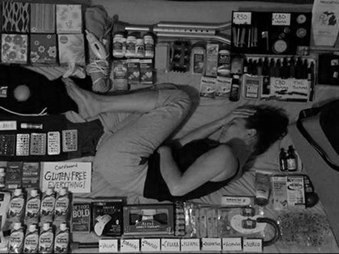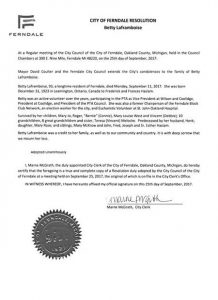AS THE EARTH TURNS AND THE COLD advances upon us, the humble but ubiquitous t-shirt becomes mostly hidden under warmer clothing except among the most hardy of us. Warding off the chill, it returns to its utilitarian function for men as an undershirt as it was at its origin. Both sexes sport them when the warmth returns, partly as an item of fashion, but often as a canvas on which we express ourselves. We want to show what vacation destination we visited, concert we attended, bands we love, goofy sayings, political slogans, our favorite sports team, and many other categories of how we want to announce ourselves when people come upon us.
T-shirts (from their shape), as we know them today, have a military origin. A little over a hundred years ago, the U.S. Navy began issuing them to be worn under a sailor’s uniform. The term itself became part of the lexicon by the 1920s. The shirts were quickly adopted by men doing industrial and agricultural work as an inexpensive, lightweight, warm-weather garment.
But, then, Marlon Brando gave the shirts a cultural and sartorial boost by wearing one in the 1951 film, A Streetcar Named Desire, while yelling for “Stella!” Brando sported one in the 1953 movie, The Wild One, and James Dean did in 1955’s Rebel Without A Cause. During that decade, a white t-shirt with a pack of Lucky Strike cigarettes rolled up in the sleeve identified it with one of the Big Scares of the 1950s along with communists —the juvenile delinquent!
By the 1960s, t-shirts, along with jeans, were associated with another generation of rebels, this time ones with many causes. Nothing rankled uptight adults more than seeing a long-haired youth sporting a pair of Levis and a t-shirt bearing the legend, “Power to the People” (still a good idea) or a clenched-fist salute.
By the next decade and onto today, t-shirts became an accepted item of apparel that can be worn almost anywhere. It’s not unusual to see a diner so attired in a pricey restaurant where previously a suit jacket was required. In fact, put on one of those atop the shirt and you are considered dressed up!
If you’re anything like me, you have so many t-shirts there isn’t room for them in your drawers and closets.  I’ve accumulated a particularly excessive number having worked in radio for years where they were issued to the staff with regularity. Every so often, I take the ones that I figure I’ll never wear again or have gotten a little too snug (ahem!) to the Salvation Army store on 4th Street in Royal Oak.
I’ve accumulated a particularly excessive number having worked in radio for years where they were issued to the staff with regularity. Every so often, I take the ones that I figure I’ll never wear again or have gotten a little too snug (ahem!) to the Salvation Army store on 4th Street in Royal Oak.
The Salvation Army defines itself as “a Protestant Christian movement and an international charitable organization structured in a quasi-military fashion,” so I try real hard to focus on their “charitable” aspect. We give our cast-offs to them, figuring we’ll be helping less-fortunate neighbors who work at the store preparing items for sale and provide inexpensive used clothing for people in need.
However, it doesn’t quite work out this way.
The Salvation Army and other charities receive way too many t-shirts and other clothing items, more than they could ever retail. After a very short stay on store racks, much of it is compressed into half-ton cubes and sold to second-hand textile processors where they take on another life as wiping rags and fiber for assorted products. Americans are so overloaded with clothing that if charities didn’t have these recycling firms, they would either have to dump the donations or turn us away.
However, t-shirts are a desired item in Third World countries, so the huge surplus are bundled into 100-pound bales and shipped primarily to Africa, but also around the world. According to a recent New York Times article, in Kenya, the locals refer to them as “the clothes of dead white people.” In Mozambique, they are labeled, often with some accuracy, “clothing of calamity.”
Reaching foreign ports, small jobbers break open the bales, compete for the best items, and sell them on the streets to ever-increasing urban populations. So that’s why you might see a Detroit Tigers or Grateful Dead shirt adorning a pedestrian in Kinshasa or Lima.
This is not to criticize the charities which sell our castoffs this way. These bulk sales provide revenue for their many programs. It’s this or the garbage dump for our discards. Americans have way more clothes than we can ever wear and they have to go somewhere.
Now, several countries in East Africa are trying to put a halt to the importation of secondhand clothing because it impedes their ability to create domestic textile industries. However, if they do this, the Trump administration has threatened to terminate the preferential trade status these countries enjoy under the terms of the Africa Growth and Opportunity Act. The office of the U.S. trade representative says this is to protect American jobs.
If used American clothing is banned from poor countries, those involved in recycling them at numerous levels of sorting, packaging, recycling, shipping, will, in fact, lose their employment. By weight, used clothing is the number-one export from the U.S.!
Wouldn’t it be nice to live in a world where someone, somewhere wasn’t getting screwed?
I’m taking a big bundle of t-shirts to the Salvation Army soon and will watch TV over the next few months to see if it winds up on a demonstrator in the streets of Nairobi or Yangon.
Peter Werbe is a member of Fifth Estate magazine’s editorial collective www.FifthEstate.org.



 Throughout her long battle with the illness, Douglas delved deeply into the study of her illness, traveling to specialists in Atlanta, and has debunked a few medical misconceptions concerning the treatment of endometriosis.
Throughout her long battle with the illness, Douglas delved deeply into the study of her illness, traveling to specialists in Atlanta, and has debunked a few medical misconceptions concerning the treatment of endometriosis.
 she’s wanted to do for a long time. When Heather’s mom died a year ago, she started to reevaluate and think about what she wanted to do with the rest of her life. A Western Michigan University graduate, with a degree in interior design and a background in business and marketing, she’s worked in retail for over 20 years. She enjoyed her most recent job at Harold Wholesale, but decided it was time to take a risk.
she’s wanted to do for a long time. When Heather’s mom died a year ago, she started to reevaluate and think about what she wanted to do with the rest of her life. A Western Michigan University graduate, with a degree in interior design and a background in business and marketing, she’s worked in retail for over 20 years. She enjoyed her most recent job at Harold Wholesale, but decided it was time to take a risk.
 Now, beginning their third season, they are excited to welcome 20 new members, bringing them to a resounding 83 members. Their members are exceptional musicians, having various talents and degrees in teaching or performing music and longevity. Twenty-five members are alumni of the Ferndale Schools (FS) Music Program, from 1969 to students who are now Freshman through Seniors in the FS program.
Now, beginning their third season, they are excited to welcome 20 new members, bringing them to a resounding 83 members. Their members are exceptional musicians, having various talents and degrees in teaching or performing music and longevity. Twenty-five members are alumni of the Ferndale Schools (FS) Music Program, from 1969 to students who are now Freshman through Seniors in the FS program. school auditorium, and is free to all those who attend. This performance is not your traditional singalong of carols. A new tradition will begin with this concert; they are encouraging everyone to wear an ugly holiday sweater or tie, and join them in a Santa march scheduled for the same day.
school auditorium, and is free to all those who attend. This performance is not your traditional singalong of carols. A new tradition will begin with this concert; they are encouraging everyone to wear an ugly holiday sweater or tie, and join them in a Santa march scheduled for the same day.
 We had nine seniors on the team qualify for FIRST scholarships! (FIRST, a robotics program founded by Dean Kamen, stands for “For Inspiration and Recognition of Science and Technology.”)
We had nine seniors on the team qualify for FIRST scholarships! (FIRST, a robotics program founded by Dean Kamen, stands for “For Inspiration and Recognition of Science and Technology.”) through FIRST robotics’.” But the team has other objectives such as: supporting local charities, encouraging students into STEM careers, obtaining additional corporate sponsorship in an effort to attract more minority and disadvantaged students, start FTC (First Tech Challenge) teams, and get additional mentors. The team has received 501(c)3 status and our main objective never changes but the team evaluates which objectives have been met and identifies new objectives on a yearly basis.”
through FIRST robotics’.” But the team has other objectives such as: supporting local charities, encouraging students into STEM careers, obtaining additional corporate sponsorship in an effort to attract more minority and disadvantaged students, start FTC (First Tech Challenge) teams, and get additional mentors. The team has received 501(c)3 status and our main objective never changes but the team evaluates which objectives have been met and identifies new objectives on a yearly basis.” and Hydro are our main corporate sponsors, which is how the team is funded. We regularly ask our sponsors, parents and community for more mentors.”
and Hydro are our main corporate sponsors, which is how the team is funded. We regularly ask our sponsors, parents and community for more mentors.”

 costumes. “It’s part of an atmosphere,” said Chris Schaller. “It’s a family event, and other families are involved in it as well. We all remember when we were little kids. Trick-or-treating was different back then. It was fun. We want the kids to feel that and keep that tradition alive. [Halloween] is a time for the community to get together, and we are a part of that. We offer a sense of community and a sense of nostalgia and a little part of tradition, hoping that this torch will be carried on with some little kid saying I want to do that.”
costumes. “It’s part of an atmosphere,” said Chris Schaller. “It’s a family event, and other families are involved in it as well. We all remember when we were little kids. Trick-or-treating was different back then. It was fun. We want the kids to feel that and keep that tradition alive. [Halloween] is a time for the community to get together, and we are a part of that. We offer a sense of community and a sense of nostalgia and a little part of tradition, hoping that this torch will be carried on with some little kid saying I want to do that.” partner is always right and you’re always wrong, if you’re always the one to blame for a mishap,if you’re never good enough, then you may be at war and not even realize it.
partner is always right and you’re always wrong, if you’re always the one to blame for a mishap,if you’re never good enough, then you may be at war and not even realize it.
 plains, deserts and thick, hot brush of Africa leaving in its wake the decimated, rotting carcasses of elephant and man. To think you’re undertaking a nice comfortable read when you first pick up the novel, Elephant Play, is your first mistake and lulls you into a false sense of normalcy. All too quickly, you’ll find yourself wondering when you left sanity behind and where this horrifying ride will take you in the end. Getting up close and personal with elephant poachers is no pretty thing. Ryals’ expert imagery may just make you vomit your lunch if you’re not careful. This novel takes you on a journey into madness entwined with a look into the gruesome and brutal ivory trade.
plains, deserts and thick, hot brush of Africa leaving in its wake the decimated, rotting carcasses of elephant and man. To think you’re undertaking a nice comfortable read when you first pick up the novel, Elephant Play, is your first mistake and lulls you into a false sense of normalcy. All too quickly, you’ll find yourself wondering when you left sanity behind and where this horrifying ride will take you in the end. Getting up close and personal with elephant poachers is no pretty thing. Ryals’ expert imagery may just make you vomit your lunch if you’re not careful. This novel takes you on a journey into madness entwined with a look into the gruesome and brutal ivory trade. ll that we live through that hideous dream and emerge from it illuminated. Or bewildered. Or diabolically amused.
ll that we live through that hideous dream and emerge from it illuminated. Or bewildered. Or diabolically amused.

 was born December 31, 1923 in Leamington, Ontario, Canada to Frederick and Frances Haslam. Betty was an active volunteer over the years, participating in the PTA as Vice President at Wilson and Coolidge, President at Coolidge, and President of the PTA Council. She was also a former Chairperson of the Ferndale Block Club Network, An election worker for the city, and Eucharistic Volunteer at St. John Oakland Hospital.
was born December 31, 1923 in Leamington, Ontario, Canada to Frederick and Frances Haslam. Betty was an active volunteer over the years, participating in the PTA as Vice President at Wilson and Coolidge, President at Coolidge, and President of the PTA Council. She was also a former Chairperson of the Ferndale Block Club Network, An election worker for the city, and Eucharistic Volunteer at St. John Oakland Hospital.